- We would like to begin by asking you what the job of the tokoyama is. There are many types of puppet theater throughout the world but a profession like yours that specializes in puppet hair dressing must certainly be a rarity.
- I believe that of all the puppet theater forms in the world Bunraku is surely the only one that has people specializing in hair dressing like we tokoyama are. In most types of puppet theater, if you are going to perform Cinderella , for example, you need a different doll for each time Cinderella appears with a different hairstyle or clothes. It’s the same in Bunraku. If you were going to perform Cinderella you would use a puppet head ( kashira ) called a musume used for young women roles, and you would have to have a different musume head for every change of hairstyle, which would lead to simply too many heads when you consider all the roles there are in Bunraku. So, what is done is to have the basic doll and change the costume and put a wig on the head that has been dressed to the desired hairstyle just like you do with live actors. That is why the profession of tokoyama hairdresser is necessary in Bunraku, just like it is in Kabuki.
- Does that mean that since olden times the same head ( kashira ) was used for a number of different roles by just changing the wig in order to economize the number of heads needed?
-
Presently, at the National Bunraku Theater in Osaka there are 320 heads, and when you add the ones at the National Theater in Tokyo, the total is under 400. That is a lot more than in the past, but with the number of titles performed in Bunraku today, that number is still not enough.
If we perform all the acts of Sugawaraden Jutenari Kagami for example, the character Matsuomaru alone requires six heads. The head used for Matsuomaru is called Bunshichi , and since the hair arrangement is different for each scene, so we have to prepare several Bunshichi heads for a performance. And, when you add the accompanying Kyogen performance and the various minor roles involved, it comes to a total of anywhere from 50 to 60 heads being used for each production. What’s more, since we are simultaneously preparing the heads for productions three months in advance, there are times when we extra Bunshichi heads for a number of plays. When that happens, there simply aren’t enough. - Could you please tell us in a bit more detail about what the tokoyama job involves and how you the actual hair preparation for these limited number of heads is one?
-
Just like the tokoyama for Kabuki actors, my job is to make wigs, dress the hair and then change it to help suit the role the puppet will be used in.
The process begins by taking a sheet of copper and make what we call a daigane (metal base). A section of the appropriate shape is cut out of the copper sheet and then it is beaten into head shape with a hammer using a mold called a tatakidai (pounding base). Then, we make something called a mino by tying hair to a pair of linen threads to make something like a veil of hair. This is then sewn into holes in the copper daigane wig base. In the case of a wig maker for Kabuki actors, this is where the wig maker’s job ends.
Originally, the wig maker and the tokoyama (hairdresser) were separate professions, but in Bunraku the same person does both jobs. I think this is because my teacher, Shoji Nagoshi, was originally a wig maker and couldn’t leave that part of the job to someone else, but he was also a fast worker and the quality of his wigs was certainly good, too. - Making the mino involves tying a human hair and yak hair onto the linen threats until they are full. Even though the heads of the puppets are small, this must be a job that requires a lot of time and perseverance.
-
Although it varies with the role and the size of the puppet’s head, making one wig usually requires three
mino
with a hair length of about 30 cm. Making these does require a lot of time, so I make it a point to find time between my other responsibilities to keep tying
mino
and maintaining a stock of them for use when necessary.
I order hair with specified length, but there are always shorter hairs in the mix. Unlike wigs for human actors, we cannot not use the soft dressing oil made by mixing vegetable wax and oil. This is because the head is made of cypress wood painted with a whitewash of water-base Chinese white pigment and if the oil permeates the head it will keep the whitewash from adhering when future maintenance requires. Since oil can’t be used to keep the shorter hairs in line, the initial “grooming” of the hair in the wig is important.
The grooming process involves gripping a bunch of hair upside-down and sorting out the short hairs. Once the short hairs are sorted out, the hair is bundled and divided into strands with the right number of hairs, which are then rounded and tied between the two linen threads one strand after the next to make the veil-like mino I mentioned earlier. The tying method is the same for the three mino that make up the wig, but the one we call the kesho (makeup) mino used for the hairline along the forehead and temples is tied with finer strands of about 20 hairs each, compared to the thicker “center mino” used in the middle of the head, which is tied with strands of about 45 hairs each. The number of hairs in the strands is something you have to be able to judge just by the feel of the strand in your hand as you select the hairs and bring them together into a strand, and since each hair is different in thickness, it is a process that really demands all your sensitivity to make even strands. - How long does it take you to acquire that sensitivity?
- At first, it is very hard to get the hairs to come together into well-formed strands in your hand. You use the right hand to pull a few hairs at a time from the bundle of groomed hair and you gather them into strand with the right number of hairs in your left hand. In the case of a kesho mino , when you get the 20 hairs of a strand together you then pull it out with the right hand and make a loop with it. But, for a beginner it is very hard to gather the hair properly in the hand. It is the same as when dressing the hair, the hairs don’t come together well in the hand. I remember once about a year or two after I started my apprenticeship, my mother came to the studio and watched my teacher at work dressing a wig while I sat nearby sweating and struggling to do the same task. Later she said that the hairs seemed stick to my teacher’s hand as if the hand was sucking them up naturally. It contrast, it looked to her as if I was struggling to pick hairs out and gather them together against their will.
- Does the hand become accustomed to the hair in the repeated process of making mino?
- Making mino is the first and fundamental stage of out training. And doing it over and over teaches us to work with patience and persistence.
- When the mino are made and attached to the metal head base ( daigane ) it is like an, undressed and slightly disheveled head of hair, isn’t it?
- That’s right. But there is also another kind of wig called an oiled ( aburatsuki ) wig. I mentioned earlier that oil can’t be used on the wigs for Bunraku, but in fact there is a kind of hair that is coated in a mixture of oil and vegetable wax until it is hard and stiff and then polished until it takes on a shiny gloss. It is like paper-mache made of hair and it is primarily used on wigs for male hero roles, like on the back part of the wig used for Matsuomaru, or for rough roles like samurai or roles that have a stiff image.
- In the case the hair for of a typical female role like the heroine O-Sono in Hadesugata Onna-maiginu , you begin with the raw, undressed hair type of wig made from mino as you just described and then do the hair dressing from that, don’t you?
-
Yes, we do. In designing the hair for the puppets for women’s roles we begin with a wig in the raw, undressed state, which is then divided into the front section of hair over the forehead called the
maegami
, two side sections called
bin
and the mounded section on the back of the head called the
tabo
. Then a comb is used to dress the hair into shape. When the hairdo is in shape, we spray it lightly with hairspray to give it a fluffy hold, since we want it to keep its shape for a long time.
When a person is given a traditional Japanese hairstyle, you use partial-wig inserts called kamoji , as you know. This is a pad of extra hair used to add volume to the hairstyle. We gather the shorter hairs that are sorted out in the grooming process of making the mino and we use that hair to make something we call a ketabo that is used like packing to fill out certain areas of the wig. Putting that packing in is actually quite difficult. It took me several years before I was able to make the shapes I wanted.
One of the characteristics of the Bunraku puppet head ( kashira ) is that the back portion of the head is quite small in comparison with the size of the face. It is as if the head is cut off in back of the forehead. Compared to the skull of a human, the rear half of the puppet head is very small. So, the back of the head is filled out with a ketabo pad of hair and the outer hair is dressed over that to look full. But if the ketabo is lumpy and shape uneven, the hair you dress over it will reflect the poor shape of the pad (ketabo) beneath it. - How many different variations of hairstyles are there traditionally in Bunraku?
- Someone counted them for me once and the number they got was 120 varieties. There are 40 for female puppets and 80 for male. But I wasn’t taught them all individually, I just learned them as I was taught while working with my teacher and others or just learned them by watching. So, I don’t know if the number is actually 120; that is just the number I have been told. I have never counted them myself.
- Why is it that there are more hairstyles for male puppets?
- There are different styles depending on the character’s personality and of course for the different roles. In the old days in Japan there were different hairstyles for people of different social status and for different professions. The reason for the large number of male hairstyles is probably related to the number of different personality types that appear in the stories and the large number of professions of the male characters. In terms of the number of different types of heads ( kashira ) used in Bunraku, again there are far more male heads than female. With the exception of special characters, the female head types include only the child, the young woman ( musume ), the old woman ( fuke-oyama ), which means there is a big jump from the young woman to the old hag. In the main types of male heads you have the young man ( wakaotoko ), the Genda (hero), the Bunshichi (warrior), the Kebiishi (official) and the Koumei (hero) and so on. And then there are a number of varieties for old men roles.
- Do the hairstyle differ for the same type of head?
- Yes, they do. Depending on what specific role the head is used for, the hairstyle will be different, and even for the same role the hair will change in different scenes of the play. For the role of O-Karu in Kanadehon-Chushingura there are three heads used. One is for when she serves as a house servant ( koshimoto ) for a samurai family, the second is for when she returns home as a young wife, and the third is for when she sells herself as a prostitute in the seventh act. For all three of these stages of her life the same young woman ( musume ) head is used and the hairstyle is also the same basic Shimada style, but within that Shimada style, three variations are used. When she is the servant ( koshimoto ), the wig is prepared in the Bunkin Shimada style, when she is married it becomes a more subdued style of Shimada, and finally when she becomes a prostitute the wig is changed to a Tsubushi Shimada style. It is these kinds of variations that bring the total number of hairstyle in Bunraku to about 120, I believe.
- Do the hairstyles change according to the tastes of the main puppeteer?
- I don’t know how it was in the pat, but I don’t believe there is not much of that today. However, with O-Sono in Hadesugata Onna-maiginu , Master Bunjaku and Master Minosuke use different hairstyles.
- Both Bunjaku Yoshida and Minosuke Yoshida are puppeteers ( ningyozukai ) who have been designated Living National Treasures and both are the most famous performers of the female roles ( onnagata ). In the act of Hadesugata Onna-maiginu that takes place in wine shop where O-Sono is acting out her concern for her husband who has not come back from visiting his lover, the eyes of the audience become riveted to the puppet’s every movement. It must be that the different images these two Living National Treasures have of the character O-Sono is reflected in the type of hairstyle they choose.
- Master Minosuke uses the Oshidori (Mandarin duck) style and Master Bunjaku uses the Sakkougai style of hair. Master Bunjaku once told me both of these hairstyles originated with Master Bungoro Yoshida.
- Bungoro was one of the great Bunraku onnagata (woman role) puppeteers of the Taisho and early Showa periods (1920s to 40s), wasn’t he? Do the Oshidori and Sakkougai hairstyle have a very different look?
- The Oshidori is the more glamorous of the two. Originally, the Oshidori was not a hairstyle used by married women. Since O-Sono is a married woman who lives in a city, I am told that Master Bungoro used to use the Sakkougai hairstyle. But after the suggest from a Kabuki actor friend, the first Ganjiro Nakamura, that he use the gay Oshidori style to match his lively puppetry, Master Bungoro changed to using that hairstyle for O-Sono. But the last time he performed the O-Sono role, he had returned to a Sakkougai hairstyle. I hear that he told Master Bunjaku, “The true hairstyle for a wife like O-Sono would have been the Sakkougai . But the audience always likes the more glamorous Oshidori style.” He told me that the person changes and so does the way he performs with the puppet. The other day, I heard from one of the Tayu that during a rehearsal the Master had instructed him by saying, “That kind of recitation won’t make for a real maegami .”
- Maegami means the hairstyle for a young male character before marriage where the hair above the forehead is bunched together like a woman’s, doesn’t it?
- Yes. It is the style used for a young man ( wakaotoko ) or a genda head. For example, we use three heads for the character Jujiro in the tenth act of the play Ehon-taikoki . All three of them use a wig with maegami , with the first having an irojasen type maegami (with a topknot). The second is when the character is headed to battle with his topknot undone, so a helmet is put on the head. The third tine the puppet appears as a wounded warrior with an increased volume of hair in a disheveled state. In this way, the hairstyles that the puppet appears with in the early, middle and final stages of the play are different, but also, the three head we prepare are different too. The first head is a young man ( wakaotoko ) , the next one is a genda without movable eyes and eyebrows and the third is a genda with movable eyes and eyebrows. I believe these changes in the type of head and hairstyle are reflections of the emotional changes the character is going through. Few people in the audience may be aware of these changes in the puppet, but that may also be a measure of how involved they become in the world that the Tayu, the shamisen musician and the puppeteer are able to weave in the course of the play.
- That means that the hairstyle of the wig you create and the choice of heads play an important role in terms of the level of artistic expression the puppeteers and the Tayu are able to achieve.
- Some of the Tayu will come to see what head is being used before the performance. In Bunraku today, Master Bunjaku is the one who decides which head will be used for each role. This decision is known as kashira wari . From old photographs we can see that in the past, some of the heads and hairstyles used for the same character in the same play were different from the ones used today. I believe that Master Bunjaku has made these changes based on his long years of experience and the intense study and reading he has done o the subject. So, I believe that in the future as well, the use of heads and hairstyles will not remain set but continue to change.
- How are the decisions of what hairstyle to use in the case of new plays? The costumes and hairstyles used in the re-staging of Shakespeare’s The Tempest in 2009 seemed to be based on styles from ancient Japan. Since new plays like this are not bound by the dictates of tradition, I felt that they could have been more imaginative in the choice of styles.
-
Even in the world of traditional theater, it would be nice if there was some strong power serving as a general coordinator with clear images to guide these choices in the case of new plays. Because it is the people working on each production that give form to these images.
In traditional theater there may be small changes made but the type of head, the hairstyle and the costume that will be used for each character in each play are already generally decided. Once it is decided what play will be produced, all it takes is a short meeting between the person in charge of costumes ( isho ), the person in charge of the puppet heads ( kashira ) and the tokoyama (in charge of wig hairdressing) to get started and have everyone proceed with their work. The final step in the process is when the main puppeteer ( ningyozukai ) puts the costume on the puppet body and then attaches the head, which has already been given fresh makeup and fitted with the prepared wig. When it is decided what play will be performed, I know what preparations I have to make, and if a certain wig has gotten too worn and needs to be replaced, making a new one that becomes part of the preparations I schedule for myself. What really impresses me about that traditional arts like Bunraku is the fact that the foundations have been laid so well that the work proceeds so smoothly. - But Bunraku has always been a completely male world. I hear that there have been women in the costume department in the past, but they were a small minority. You are the first woman ever to become a tokoyama in Bunraku. What made you want to become a Bunraku tokoyama?
- I always liked Japanese traditional hairstyles, and I liked period dramas, and princesses … (laughs). I don’t know whose influence it was, but I was like that even before I went to nursery school. My mother worked so a woman in the neighborhood always babysat for me. She was an older woman and skilled at sewing and she would sew little kimonos for my Barbie doll from scraps of cloth, and she would dress up its hair in two traditional Japanese hairstyles, telling me, “This is a momoware hairstyle,” or, “This a Shimada style.” I wanted to be able to do that too, so in my first or second year of elementary school we used to get one of my friend’s little sisters who had long hair and dress her up in my kimono and do up her hair, putting in traditional kanzashi hair pins and making little paper dolls.
- So that was the start of it all?
- I think so. Today we are in a period of re-discovery of tradition and many young people are traditional Japanese culture, but back in the late 1950s and early 60s when I was growing up I believe it was an era when everyone was trying to rid themselves of the old traditions and throw out its remnants. People were longing for Western culture, girls wanted to wear dresses, not kimonos, and I had some of that in me. I liked Cinderella and Snow White. But above all I like the traditional Japanese princess in a kimono with long sleeves and lots of gaudy traditional hairpins in her hair. What I loved was the world of the television period drama Kotohime Shichihenge . All my friends were crazy about the young boy bands in pop music, but my idols were period dramas actors like Kinnosuke Nakamura.
- So, that love of period dramas made you want to become involved in a profession related to that world?
-
I can’t really say that is true. I didn’t want to become involved in creating that world, I think I actually wanted go back to the Edo Period (1608 – 1867). If it were only possible, I would have wanted to be become a person of the Edo Period (laughs).
All through junior high and high school I was in an arts school system. My education was focused in the arts and I belonged to the Kabuki study club. I was immersed in the traditional arts. But when I went on to college, I rebounded and became interested in Western movies, watched Marcel Marceau and German marionette puppet theater. When I went to Europe as part of an art history course people there would speak to me in English and I was so embarrassed because I could hardly speak a word of English. I was afraid to try job hunting right out of college so I went to Los Angeles to study on a shortsighted plan. - You had given up your love of the Edo world?
-
Yes. It surprises me how fickle I was. It was just that I was worried about devoting myself completely to the traditional arts. After college and working in the US for a while, I came back to Japan and started looking for a job, but it was hard to find one. I was taking my time.
I got a part-time job working at an archeological excavation site where the old Nakano Prison was in the Numabukuro district of Tokyo. It was interesting because we were uncovering the ruins of old homes and graves, and I enjoyed the physical labor. But I wasn’t going to start studying to become an archeologist. My parents were starting to get anxious about me around that time, so I took a job in a computer programming company, hoping that it might eventually connect to my interest in computer graphics. But I had no experience as an office worker and I didn’t even know how to use the copy machine. As for programming, the language was constantly advancing and I couldn’t keep up. I was almost 30 by then and it was difficult just being at the starting line in terms of a profession.
Knowing that it takes at least ten years to become a professional in most jobs, I realized that at the age of 30 this would be my last chance. So, I began to think seriously about what I wanted to do. In the end I realized that I wanted to work in the theater doing wigs. My feeling was also one of fear, however, because if I got a job I enjoyed in such a sacred place but couldn’t make the grade, I was afraid that I wouldn’t be able to recover from the failure. So I feared getting too close to such a sacred place. But in the world of the traditional arts, even a person like me who couldn’t use a computer might still be useful as one of the clogs in the wheel. I knew I liked dolls and puppets and I knew I liked wigs and the traditional arts, so I thought I would like to become a tokoyama in Bunraku. One of my upper classmates since junior high was the wife of a Bunraku Tsukomadayu Takemoto, and she told me that they were having difficulty finding successors for the tokoyama job in Bunraku. She said that the 57-year-old tokoyama, Shoji Nagoshi, was doing the job all by himself. - Even though they were looking for someone to train as a successor, your school friend would have to be quite adventurous to recommend a women for the job in the exclusively male world of Bunraku.
- The Bunraku theater had included an article in their promotional magazine soliciting applicants to be trained as successors, but they got no response at all. Nagoshi had apparently been expecting there to be at least one or two men applying for the position, so he was in shock at the result. It happened to be at a time when gender equality in the workplace had become an issue throughout Japan, so the article said there was no gender discrimination regarding applicants. So, when the Bunraku company was in Tokyo for performances I went backstage and told them that I wanted to train, but the answer was naturally “No.”
- But you didn’t give up.
- That’s right. That was 23 years ago. At the time I thought that if I let a No turn me away, I would never make it. So, I kept going to the theater after work and on the weekends and went backstage to ask again and again. Thanks to the recommendation and cooperation of my school friend, I went to visit the National Bunraku Theater the following month, in June. The second time I went I had already found an apartment and in July I quit my job and moved to Osaka to force the situation. You could say that I just started a kind of unpaid sit-in at Nagoshi’s studio. I was still young and full of drive (laughs).
- So, even though Nagoshi san had said No, he didn’t completely reject you, did he?
-
When I first met him in Tokyo, Nagoshi had said, “If only you were a man.” When I asked him if he would have hired me if I were a man, he said “Yes.” So, I realized the only reason behind his refusal was gender and optimistically interpreted that to mean he accepted me as a person.
Nagoshi is a very sincere person and I believe he wanted to encourage me to give up the idea of taking on the job by telling me how hard it would be. He told me that the job required going on tour and how hard that was on a woman. And to show me how difficult the actual work was, he had me start the painstaking work of making mino. I might have given up if he had simply paid no attention to me, so that move turned out having the opposite effect. It made me feel that this was a master I wanted to follow as an apprentice. I was sitting in front of a closed door and I thought that if I ever looked back that door would never open again. So I only though about sitting there until it opened. I never let myself think that it wouldn’t open. - Once in Osaka, did you go backstage to the studio everyday?
-
At the time, it ad just been a year or two since the Bunraku company had moved from its home theater to the newly completed National Bunraku Theater and the tokoyama studio there in Osaka was still in complete disorder. My school friend boldly took me there and left me there saying, “Just think of her as a vacuum cleaner.” I have been really lucky to have the support of many people like that along the way.
In the workshop at the time there was hair and copper sheets, hammers, combs, materials and tools lying all around in a jumble. It was a mess and dirty, with bugs coming out occasionally. Personally, I didn’t have a problem with messy rooms, and the things lying around like Japanese hairpins, crepe and fabric scraps were all treasures in my eyes. I was happy just being there. I did my best to try to get Nagoshi to open up just a little and teach me even one thing to do, or explain anything to me. Even if I wanted to clean up the workshop, I didn’t know what was used for what, so I would ask him everything. As I began to get the shop cleaned up, next there was the problem that Nagoshi couldn’t find the things I had put away, so he was always asking where I had put this and that. Now I had to worry that I wouldn’t be able to find something he needed, but at the same time I felt it was great because at least he was talking to me. - Since the skills of the craft take time to pass on, I’m sure that Nagoshi san at 57 was thinking seriously about training a successor. Then you showed up.
- Now, I am in the same situation he was in at the time and I can begin to understand how he must have felt. Anyway, there I was working for free every day and the theater couldn’t let that go on forever, so after two month they started paying me apart-time salary, and after another year or two they made me a full employee of the Bunraku theater.
- Nagoshi san is of the old school of learning that believed that skills should not be taught but “stolen” by watching your teacher and imitating. As a result, he has no manual of the tokoyama craft. So, how did you learn the techniques of your craft?
-
The best way to learn in a situation like that is to start from zero and just humble yourself and absorb everything. Saying it this way may sound a bit abstract, but I believe that the best way to grab every bit of information your teacher is willing to give you in a situation like that is to throw out your pride and completely humble yourself. Make yourself empty and just breathe everything in. You must become an observer of all that is going on, and then you have to have the determination to try everything yourself. If you don’t try to do it, you won’t know what you don’t know. Nagoshi would show me how to do things once or twice, and then it was up to me to try doing it myself. Once you have done it several times your body begins to learn the process. As log as you are still thinking about the process, you haven’t learned it, it hasn’t become part of you. Nagoshi is one who went through his training in the old days [when apprentices learned by “stealing” knowledge and technique through observation rather than being taught], but he is also a very progressive person and when I couldn’t do something he would join in and think with me about what I was doing wrong. He was always willing to teach me whenever I asked him about something.
The first hairdressing technique I had to learn was something called magesabaki . It is a device for making the Shimada or whatever hairstyle come undone in an instant at a dramatic moment during a play. The established process for dressing the hair is very efficient, without a single wasted action. I feel it is a testament to the strength of the heritage that our predecessors built and handed down generation after generation. But, what I admire so much about Nagoshi is that he always told me that the traditions are never perfect. “Improvise,” he would always tell me. There will not be big changes in the techniques or the materials, but there are always parts where improvising can improve things, and I believe that if you don’t continue to use your imagination to improve things in that way, the tradition will die. So, I am very glad that I had a teacher who told me, “Don’t change the fundamentals but never stop trying new variations.” Once a process becomes your own, it is important to keep chewing on it as something of your own that can still be improved. And as you keep chewing, it will be great if you can make even one innovative improvement in the process.
Of course, it is very difficult to master something at first. But if you give up at that point, it will be taken away from you. That is frustrating, of course, and you don’t know when you will get another chance. So, while waiting for that next chance, I would always hang around the master while he was working and watch intently, to learn the working process and get a feeling for it. Learning for me was a repetition of this process. - When was it that a wig you had dressed was first used on the stage?
- It happened earlier than I expected. I first started working regularly in Osaka in July, and by March of the next year, wigs I had dressed were officially being used on stage. Nagoshi was away on tour, so I was put in charge of preparing the wigs for the Osaka performances. Every day I went up to the lighting room to peek down at the stage. I was so worried that there might be a problem with one of the wigs I had prepared that I kept up the habit of secretly peeking in on the performances for a year or two. I finally stopped watching the performances every day after Nagoshi said to me one time, “You’re a pro now and you’re supposed to be able to dress a wig, so show a bit more confidence.” But even now, I will look in a couple of times during the run of play to see how the wigs actually look on stage.
- Do you change the wigs if you don’t think they look good on stage?
- Yes, I do change them. If the balance isn’t good because the mage is too big, for example, I want to make adjustments and have it looking better for the next day’s performance. Sometimes I also get requests from the puppeteers. There was one time when Minosuke was using a puppet in a scene where the hairdo was supposed to unravel ( sabaki ), but when he pulled out the stopper to make it unravel, the hairdo didn’t fly apart all at once as it is designed to but gradually swelled out came apart slowly as the doll was moved around. It just happened that way, but Minosuke liked it. So the next day I started thinking of ways to modify the device so it would gradually come apart that way every time.
- As the diet of the Japanese changes, the color and quality of our hair must be changing, and a lot of women wear their hair short now, so it must be becoming more difficult to get enough hair for making wigs, isn’t it?
-
We use human hair and yak hair for making the wigs, and in both cases most of what we use today is imported hair. Probably 90% of it comes from China. It come to us washed and dyed as raw hair. Once we dress a wig, it keeps its form well through the run of a play’s performances unless there is some accident or it is a wig that is deliberately made to come unraveled in a
sabaki
. Once a the hair of a wig has been kept in shape like that for a month, it takes a set that has to be straightened out again by heating it before it can be used for the next wig dressing. If it isn’t natural hair it can’t be straightened using moisture and heat, and synthetic fibers like polyester will melt when heated.
Recently, one of the chemical companies has developed a hair substitute made of synthetic protein, and since it is synthetic protein it won’t melt under heat, but it still doesn’t have the same qualities as natural hair. For example, the gloss of synthetic white hair is different from that of natural white hair. With the so-called goma no ke (sesame hair) we use for making a wig for the puppet of an elderly character, the dark part of the hair has to be a bit brownish, not pure black, in order to get a color with good contrast when the dark hairs and white hairs are mixed together. The deeper the black is the stronger the impression it gives of an ornery old man, and the more white there is the more we feel he is a nice old man. I think it would be very hard to get that kind of subtle expression with artificial hair. For Bunraku, the length of hair we need for wigs isn’t that long, so I think we will still be able to get the hair we need for some time, but in the long run it will probably be hard getting enough human hair. - Getting raw materials like those is a big problem, but the issue of training successors for the art is another big concern. You are here to handle the wigs during the first half of the Tokyo performance runs, but when you go back to Osaka to prepare for the next run, 80-year-old Nagoshi san is left in charge all by himself. This precarious state of affairs has to be changed, doesn’t it?
-
Yes, it does. Since November of 2008 I have a 27-year-old woman working very hard with me. Before her, there were there were a couple of men who worked with me for a while, but unfortunately they didn’t continue. I tried my best but it didn’t work out. As far as the skills are concerned, you will learn them if you have the persistence to keep at it, but when it comes to sensibilities like what colors should not be used on the puppet for an honest, respectable character, it is a much more difficult matter. With our living environment so different today from that of the Edo period, how are we supposed to learn these subtleties?
For someone like me born in the later half of the 1950s these are sensibilities it is hard to be certain about. I have learned what I know by listening to Nagoshi who know Bunraku before the War and Master Bunjaku, who is known as a walking dictionary on Bunraku. The hairstyles used in Bunraku are not necessarily an accurate reflection of the cultural history and customs of the Edo Period. There are many “dramatic lies” born of what looks best on the stage and what suits a character best. And these are sensitivities that cannot be acquired simply by reading books about the history of Edo culture. It is all well and good to be able to access information from a variety of different media, but that won’t bring you all the answers. I want to be a person who continues to trust my observations and thinking. - Is that why you have recorded what you have learned in your “Ledger of Wig Application”?
- I began keeping the ledger as reminders for myself. For a long time, Nagoshi was the only tokoyama in Bunraku, and that kept him busy all the time with the performances, which made it impossible for him to make a record of the information needed for the different plays. At one point in time he unfortunately became incapable of continuing the record he had been compiling. That must have made him worried, because he began to say that he could die anytime and then I would have to carry on all by myself. He asked me if I was confident I could take that responsibility. From that moment on I have been preparing myself and being careful not to waste a single moment. The thought really frightened me. I can’t perform my job unless I know what characters will require what wigs in each scene of the plays in the each performance run. So, I worked frantically to complete this ledger of mine. Since then I have been weeding out repetitious parts and adding new records for plays that haven’t been performed in decades and making sure to make notes when a wig is different from the one used in past performances, etc.
- Now that you have the ledger and you have a successor in training, the worst of the crisis is over. What’s more, since your successor is also a woman, it looks like you have overcome the gender barrier, haven’t you?
-
Regarding the two men who quit in the past, I believe it as not a matter of gender but a matter of individual character that made the work difficult for them. There are always difficult aspects to any job, so I feel it is a question of how you approach those aspects. Nagoshi believes the craft is a life-long learning process, and he always says that this job is not a short-distance race, so I hope the next generation of successors will pace themselves well for the long haul. It would be best if we had three people working in the tokoyama department but presently there are just the two of us working fulltime. Although he is retired now, Nagoshi is still in good health and helps us out so I am able to carry out my responsibilities and keep the performances going while train my successor at the same time. But if one of us got sick I am frightened to think what would happen.
It is difficult being a pro in this profession and carrying out all its responsibilities. When I first started out I was doing it because I liked it with a passion, but ever since I realized that being a pro means receiving a salary while learning the profession, I feel that I have been able to accept that responsibility. I am a person who can only do things I am interested in (laughs) and I feel truly fortunate to have been able to do this work I like as a hairdresser. It may be my own selfish wish that my successor will also come to love this tokoyama work like I do. It is fun when you can do work that you truly have an interest in. But since it is still a job nonetheless, we are probably lucky if there is one in ten parts of our jobs that we really like. For that 10% that we like the other 90% must be endured. I believe that is what work is.
Akiko Takahashi
Another fascination of Bunraku - The world of the “tokoyama” hair designer
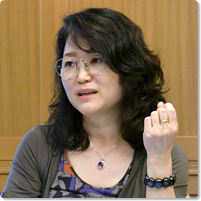
Akiko Takahashi
Bunraku puppet hair dressing artist
Chief Technician of the Technical Office of the Bunraku Technical Department of the National Bunraku Theater. Born in Tokyo, Takahashi graduated from Joshibi University of Art and Design and subsequently studied in Los Angeles, USA. Form 1987 she trained under Shoji Nagoshi, tokoyama artisan of the National Bunraku Theater. In 1996, she was recipient of Osaka city’s Sakuya Konohana Award for here efforts in completing a Ledger of Wig Application.
The Puppet Theatre of Japan “BUNRAKU”
https://www.ntj.jac.go.jp/bunraku/
Interviewer: Kazumi Narabe, journalist
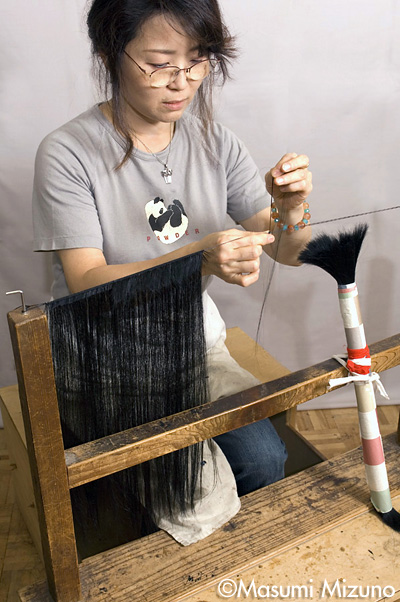
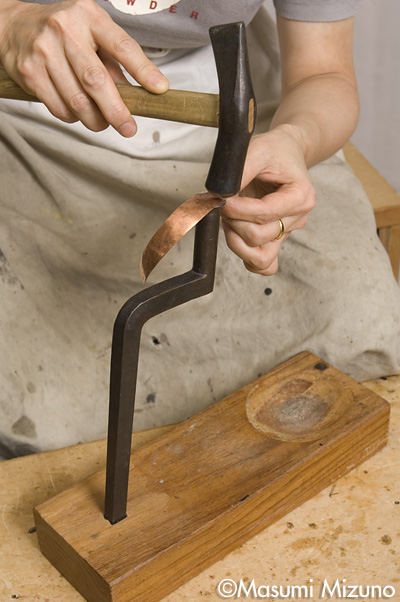
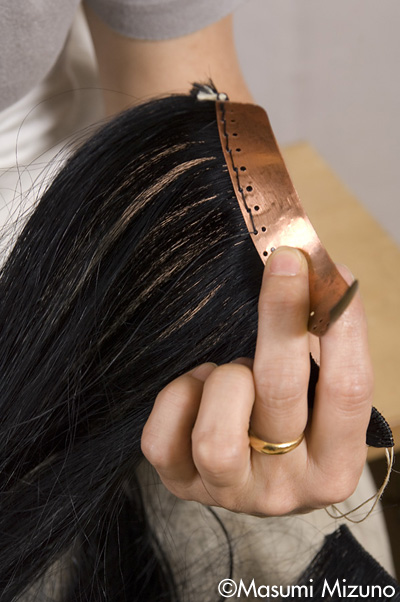
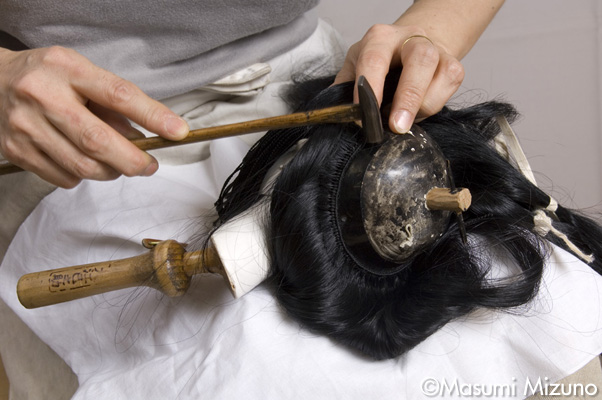
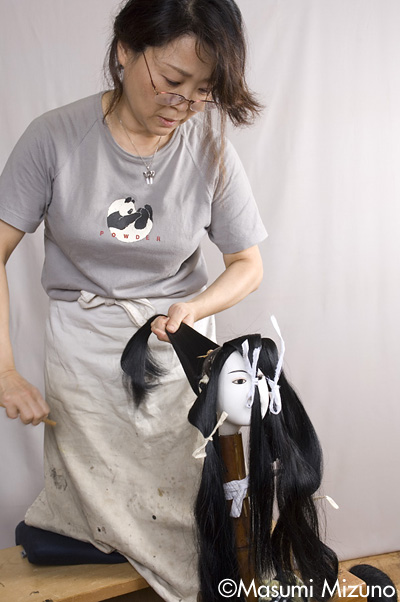
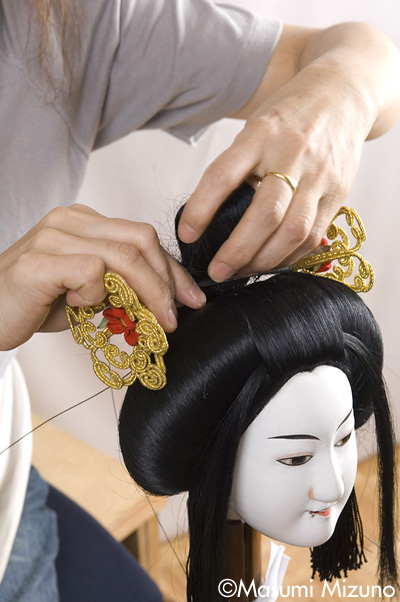
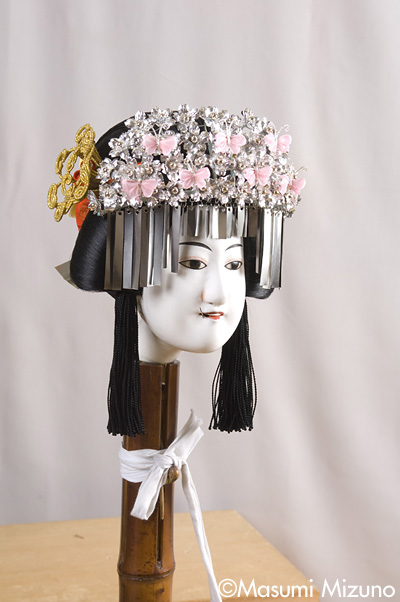
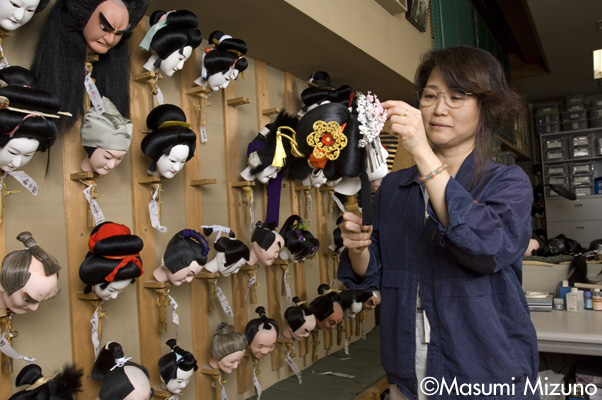
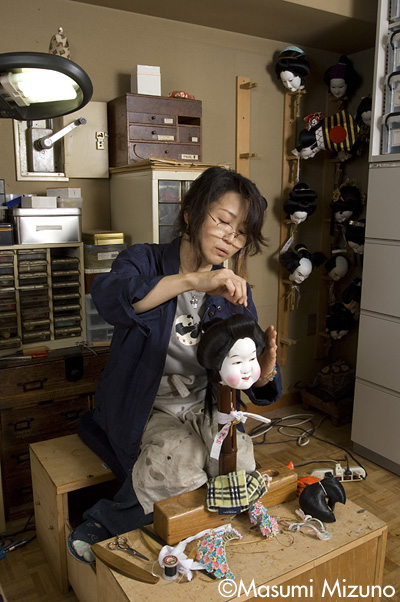
Photo: Masumi Mizuno

